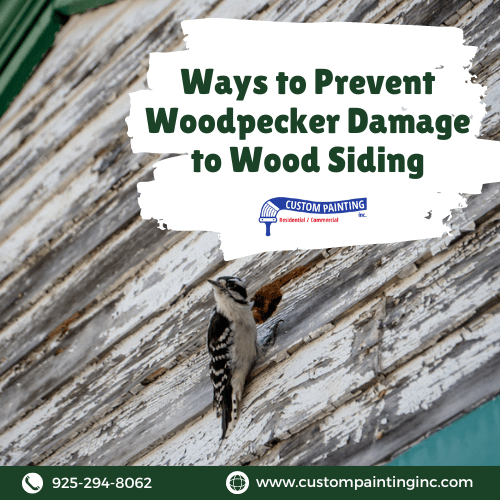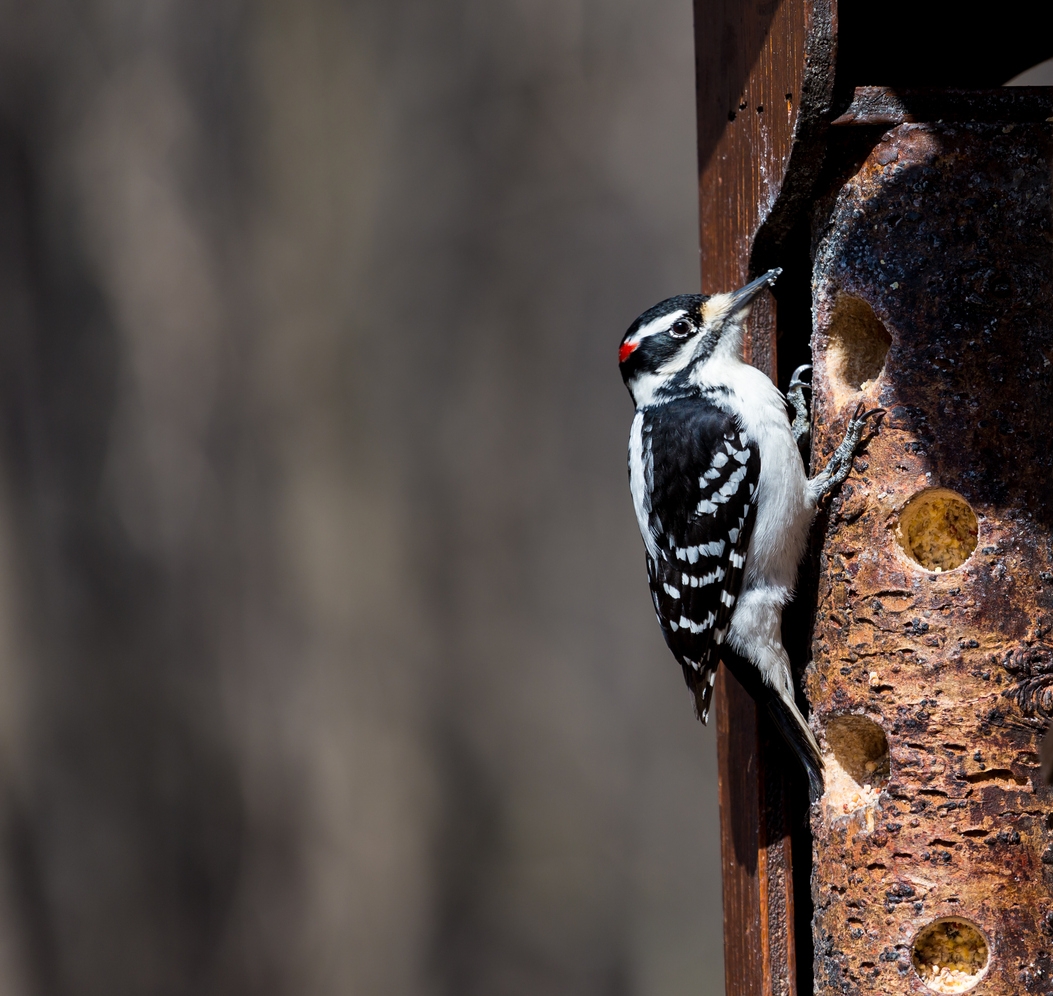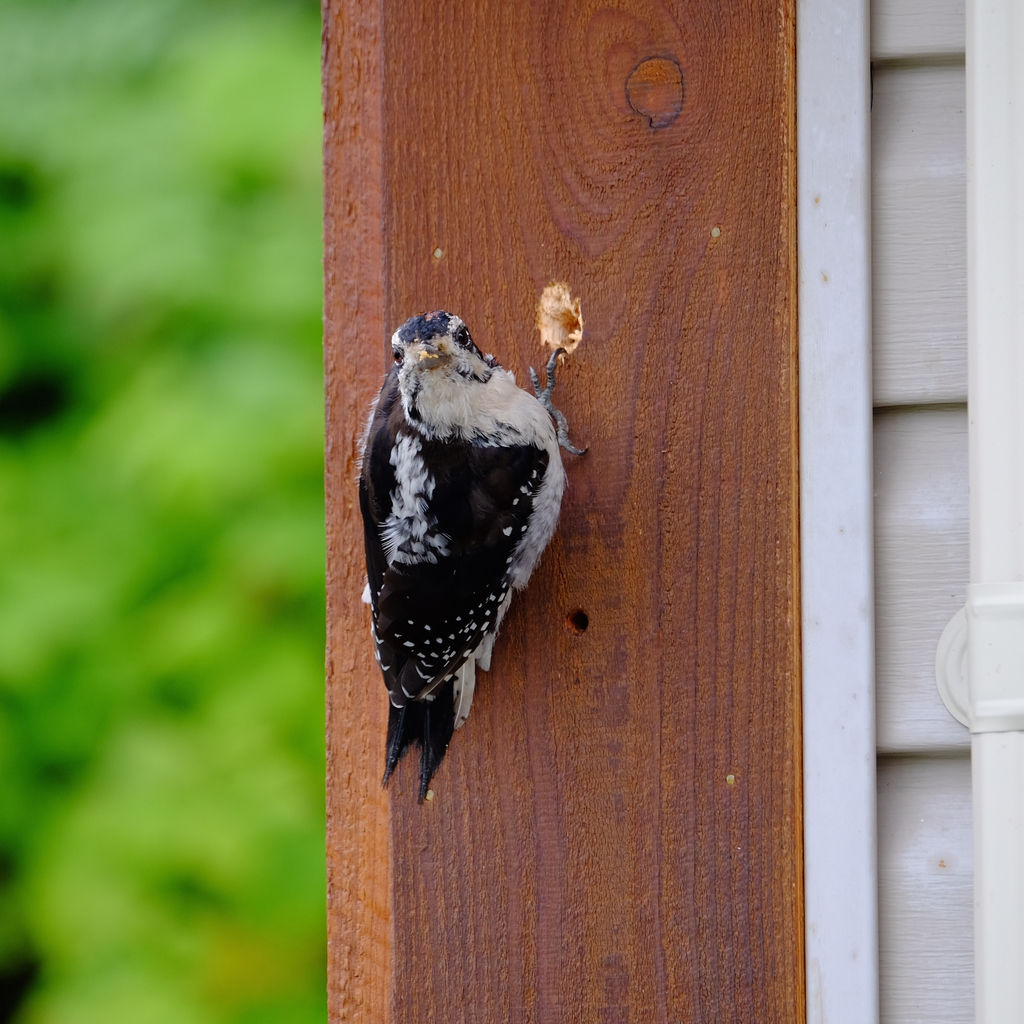If you live in a rural area or the suburbs backed by woods, you may have encountered woodpeckers causing extensive damage to your home’s exterior and being exasperated by them. Woodpecker damage to wood siding is a common issue for homeowners. These birds peck at wood to find food, create nesting sites, or mark their territory.
This behavior can lead to unsightly holes, structural damage, wood rot, and potential entry points for pests and moisture. Protecting your home from woodpecker damage is crucial to maintaining its aesthetic appeal, structural integrity, and overall value.
Understanding woodpecker behavior
Here are a list of common reasons why woodpeckers peck on wood siding:
1. Foraging for food: Woodpeckers peck on wood to find insects and larvae hidden beneath the surface. The insects often reside in decaying or insect-infested wood, making wooden siding an attractive target.
2. Creating nesting sites: Woodpeckers excavate cavities in wood to create nests for their young. These cavities are usually in dead or decaying trees, but wood siding can also be used if it’s accessible and meets their needs.
3. Drumming for communication: Woodpeckers drum on resonant surfaces to communicate with other woodpeckers, especially during mating season. The sound can mark territory and attract mates. Siding, especially hollow or lightweight wood, can produce the desired loud sound.
4. Food storage: Some woodpecker species, like the acorn woodpecker, peck holes to store food. They create holes in trees or wooden structures to stash acorns and other food items.
Common Types of Woodpeckers That Cause Damage
- Downy woodpecker (Picoides pubescens): They are small in size, with a white belly and black wings with white spots. They are common in urban and suburban areas and can damage siding, trees, and wooden structures.
- Hairy woodpecker (Picoides villosus): They are similar in appearance to the downy woodpecker but larger. They are also found in various habitats and can peck on wooden sidings.
- Northern flicker (Colaptes auratus): A larger woodpecker with a distinctive black bib and spotted belly, the woodpecker usually pecks on homes and structures, especially during the breeding season.
- Pileated woodpecker (Dryocopus pileatus): One of the largest woodpeckers, with a distinctive red crest. They can cause significant damage due to their size and powerful pecking.
- Acorn woodpecker (Melanerpes formicivorus): Known for creating granaries to store acorns. They can create numerous holes in wooden structures for storage.
Signs of woodpecker activity on your property
- Visible holes: Small, round holes in a linear or clustered pattern are common signs. Larger rectangular or oval holes may indicate nesting cavities.
- Pecking sounds: Repeated tapping or drumming sounds, especially early in the morning or during the breeding season.
- Wood chips on the ground: Accumulation of small wood chips or debris beneath the pecking sites.
- Damage to wooden structures: Noticeable damage to siding, eaves, fences, and other wooden elements.
- Presence of insects: An increase in insect activity around the damaged area might indicate that woodpeckers target an insect infestation.
Understanding these behaviors and signs can help you take appropriate measures to mitigate woodpecker damage and protect your property.
Preventative measures
To prevent woodpecker damage on wood siding, you can implement the following measures:
- Visual deterrents: Utilize reflective objects like shiny tape or CDs, predator decoys (such as owl or hawk models), and wind chimes. These create visual disturbances that can scare woodpeckers away by mimicking predators or causing discomfort.
- Physical barriers: Install netting over the affected areas to access the siding physically. You can also use metal flashing on vulnerable spots or opt for woodpecker-resistant materials like fiber cement or vinyl siding, which are less appealing for pecking.
- Auditory deterrents: Employ noise-making devices such as banging pots or specialized woodpecker deterrent devices. You can also use ultrasonic repellents, which emit high-frequency sounds that are unpleasant for woodpeckers but inaudible to humans.
Combining these methods can effectively reduce the risk of woodpecker damage to your wood siding.
Repairing existing damage
Repairing wood siding damaged by woodpeckers involves a few steps: assessing the damage, repairing the holes, and then repainting and sealing the area to protect it from further damage. Here’s a step-by-step guide to tackling this issue:
Assessing the extent of the damage
Before starting any repair work, it’s crucial to assess the extent of the damage to determine the best approach.
- Inspect the siding: Look for holes and any structural damage caused by the woodpecker. Small, shallow holes are usually less severe, while larger, deeper holes can indicate more significant damage.
- Check for insects or rot: Woodpeckers often target wood infested with insects or suffering from rot, so inspect the area for signs of either. If you find any, you must address these issues before repairing the wood.
- Determine the scope of repairs needed: If the damage is extensive, covering a large area, you may need to replace entire sections of siding. For smaller, isolated holes, filling and patching should suffice.
Filling holes and repairing wood siding
Once you’ve assessed the damage, repair the affected areas.
- Clean the holes: Use a brush or vacuum to remove any loose wood fibers, debris, or dust from the holes. If there are any insect infestations, treat them accordingly before proceeding.
- Choose the correct filler: Use a high-quality wood or epoxy filler for small to medium-sized holes. For larger holes, you may need to use a wood patch or insert a piece of matching wood before applying filler.
- Wood filler: Mix and apply the wood filler according to the manufacturer’s instructions, using a putty knife to press it into the holes. Overfill slightly to allow for sanding later.
- Epoxy filler: An epoxy filler can provide more structural integrity for deeper holes. Mix the epoxy components as directed, then fill the hole, shaping it as closely as possible to the original wood contour.
- Sand the repaired area: Once the filler or epoxy has dried (usually after several hours or overnight), sand the area smoothly with fine-grit sandpaper to ensure it blends seamlessly with the surrounding wood.
- Prime the area: Before painting, apply a coat of primer to the repaired area to ensure proper paint adhesion. This step is crucial to prevent moisture from penetrating the wood, which can lead to rot.
Repainting and sealing the repaired areas
After repairing the siding, it’s essential to protect the wood from future damage by repainting and sealing the area.
- Select matching paint: Choose a paint that matches the color and finish of your existing siding. If unsure, take a small sample to a paint store for color matching.
- Apply the paint: Use a brush or roller to apply paint over the primed areas, blending it with the surrounding siding. You may need two coats for full coverage, allowing each coat to dry thoroughly before applying the next.
- Seal the paint: After the final coat of paint has dried, apply a clear wood sealer or exterior-grade paint sealer over the entire area. This will add an extra layer of protection against moisture, UV rays, and potential woodpecker attacks.
- Monitor and maintain: Regularly inspect your siding for new damage, and reapply sealant as necessary to protect the wood.
Preventing future damage
Consider implementing preventive measures to avoid further woodpecker damage. This might include installing deterrents like bird netting, reflective tape, or sound devices. Also, ensure your siding is well-maintained, as woodpeckers are less likely to target healthy, well-sealed wood.
Long-term maintenance and strategies
Consider the following long-term maintenance strategies to protect wood siding from woodpecker damage:
- Regular inspections for early detection: Frequent inspections allow homeowners to identify and address woodpecker damage early before it becomes severe. Promptly repairing small holes or areas of damage can prevent woodpeckers from returning to the same spot.
- Using woodpecker-resistant materials and finishes: Opting for materials like fiber cement or composite siding, which are less appealing to woodpeckers, can reduce the likelihood of damage. Applying finishes that make the wood harder or less attractive to woodpeckers, such as certain paints or stains, can also help deter them.
- Landscaping changes to discourage woodpeckers: Altering the landscape around the home can make the environment less inviting to woodpeckers. Removing dead trees or branches that woodpeckers might use for nesting or drumming and planting trees or shrubs that are less attractive to them can reduce the chances of them targeting the house.
Dealing with persistent problems
Dealing with persistent woodpecker damage to wood siding can be challenging, but there are several strategies you can use to mitigate the issue. Here’s a breakdown of your options, covering professional pest control, legal considerations, humane methods, and community resources.
Professional pest control options
Hiring a professional pest control service is a practical step if woodpecker damage is severe. These professionals can offer a range of solutions, including:
- Installation of deterrents: Professionals can install physical deterrents such as bird spikes, netting, or metal flashing on vulnerable areas of your home to prevent woodpeckers from accessing the siding.
- Sound repellents: Some pest control companies use sound repellents that emit noises woodpeckers find disturbing, encouraging them to leave the area.
- Visual deterrents: To deter woodpeckers, you can install reflective materials or objects, such as scare balloons and fake predators.
- Chemical repellents: Non-toxic chemical repellents can be applied to siding to make it less attractive to woodpeckers.
- Repair and restoration: Professionals can also repair the damage caused by woodpeckers, including filling in holes and repainting.
Legal considerations and humane methods
Woodpeckers are often protected under the Migratory Bird Treaty Act, which makes it illegal to harm or kill them without a permit. Here’s how to approach the problem within legal and humane frameworks:
- Humane deterrence: Always aim to use non-lethal methods to discourage woodpeckers. Visual, sound, and physical deterrents can be highly effective.
- Exclusion techniques: Installing netting or other barriers to physically block access to your siding is a humane and effective solution.
- Habitat modification: If woodpeckers are attracted to your property because of a nearby food source, like insects in the wood, addressing the root cause can reduce their interest. Ensure your home is free of termites or other wood-boring insects.
- Permits for removal: If woodpecker activity becomes excessively destructive and all humane methods have failed, you may need to consult with local wildlife authorities about obtaining an official permit for more aggressive control measures. However, this is usually the last resort.
Community and expert resources
There are several resources you can turn to for advice and assistance:
- Local cooperative extension services: Many regions have cooperative extension services that provide advice on wildlife management. They can offer specific recommendations for dealing with woodpeckers in your area.
- Wildlife rehabilitation centers: These centers often have expertise in dealing with bird-related issues and can guide you on humane deterrence methods.
- Neighborhood associations: If woodpecker damage is a common issue in your area, collaborating with your neighbors might be effective. A community-wide approach can help create a more comprehensive deterrent.
- Online forums and expert blogs: There are many online resources where homeowners share their experiences and solutions to similar problems. Websites like Audubon Society or other bird-focused organizations often have sections dedicated to dealing with woodpeckers.
- Professional ornithologists: In some cases, consulting with a bird expert or ornithologist can provide unique insights into the behavior of the woodpeckers and suggest specific strategies that may not be widely known.
Addressing woodpecker damage requires a multi-faceted approach, balancing professional pest control options, legal and humane considerations, and leveraging community and expert resources. The key is to use a combination of deterrents and repairs while staying within legal and ethical guidelines to protect your property and the birds.
Conclusion
Implement effective prevention strategies to protect your wood siding from woodpecker damage. These strategies include installing deterrents, maintaining your home’s exterior surfaces, and addressing any signs of damage promptly. Taking these steps helps you safeguard your home’s exterior and avoid costly repairs in the future.
If you’re facing woodpecker issues or need professional assistance, call Custom Painting, Inc. at 925-294-8062 or message us via our online contact form. Our experienced team is ready to help you protect your property and keep it looking its best. Contact us today to learn more about our services and how we can assist you.




